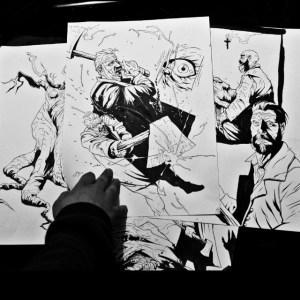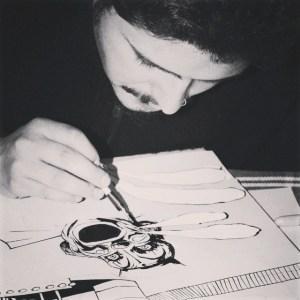Like the header of our blog? Well, who wouldn´t! The artist´s name is Fábian Rivas Belmar, an illustrator and author from Chile, who provided us in following interview an insight into his world.
 What was your first approach in the world of comics?
What was your first approach in the world of comics?
I think I have drawn as long as I can remember but I never took it seriously until the last past years. When I was a child I watched a lot the “Batman Adventures” of Bruce Timm, the animated series and the comics that were not expensive at this time. His dark but simple style drew my attention and it got me into the world of comics. From there I got to know some authors who influenced me: Like Frank Miller who has a personal and unique style and from whom I learned the importance of black in a drawing. This high contrast is typical for him what helps to understand the basic points for drawing. Something similar happened to me with Mike Mignola, the Jack Kirby of our generation, his simple style changed my way of thinking. Other authors who interested me at the time and which appeared in some Batman or Sandman comic were Sienkiewicz, Dave Mckean, Kent Williams and Teddy Kristiansen who share a very dynamic, expressive and violent style without leaving out the details.
What meaning does art have in your life?
I always liked drawing but today the graphic narration draws more my attention. A good artist is not necessarily a good graphic storyteller. It´s a fascinating and above all a very underestimated form of art that keeps my mind occupied all the time.
When and how did you learn how to draw?
Like I said I have always drawn, since I was one year old. For me it was always almost instinctive until the moment when you hit that obstacle that you have to learn to draw academically in the school of art. Our teacher always said that it was more difficult to teach somebody who already knows how to draw than someone who doesn´t. The idea is to polish the style. It may sound paradox but it´s complicated to keep a simple style.
Do you remember the first drawing that you shared with your family or friends? What was your first amateur comic?
When I was a child I was obsessed with circles and spirals which my mother discovered were cars. But after that I started a large history of copying authors and I made my own posters of DC and Marvel Comics. Unfortunately I kept nothing of this stuff. And my first amateur comic were drawings that I did in high school with a great friend and schoolmate, Alejandro Jarpa, with whom I share the same affinity to the world of comics until today.
Where did you get your artistic education? “Do it yourself” or in an art school?
I learned more by myself, even when I was in the school of art. And that is not because I had bad teachers, on the contrary, I did, nevertheless I always learned faster when I tried it myself. But there were teachers like Claudio Romo who taught me various things that would have been otherwise very bothersome to learn by myself. It´s always good to be close to someone professional.
How do you start realizing a page? Tell me about your creative process!
It´s common that people treat a page of a comic like it was a movie without movements. Then you join the photograms and the layout along the pages while omitting the fact that the language of a comic has its unique characteristics. For me the montage of a page is a large process: A lot of sketches, changes, decisions – that´s where the graphic narration happens. Putting the ink is more mechanical and it depends a lot from if you do it analog or digitally.
What do you prefer, anolog or digital?
There is no comparison to the analog work, it´s a process that always has beautiful results. But lately I chose more the digital way because it´s faster and easier, especially when you have a deadline or when you don´t have a permanent place for working.
Do you usually inform yourself for a project before you start drawing? Can you tell me some graphic novels that you have worked on?
Yes. It´s part of the work that there´s not only a referential necessity, but also you have to know your characters and the locations. There was a documentation of age in the graphic novel “Iris y Fértil” I did, and in the fanzine “Anibal” was a documentation of the locations. For the comic “Predicador” I used the material of my friend Yayo that already existed to create the characters. Also in the graphic novel “Trash Days” we based the characters on some actors of the cinema. So it´s typical to inform yourself. But I think it´s also important for the moment of creation and design. The documentation sometimes provokes you to renew and change things. It´s always more easy to modify what´s already existent than develop something from nothing. Something that does not exist in reality always is based on something that already exists.
Is it complicated to work in a group with authors in the role of a graphic artist?
No, I don´t think so. The only thing you need is to speak the same language or belong to the same environment. But maybe it´s complicated when it comes to the intimate and personal work, when there is no connection between the participants or they want to express different things. So that may jeopardize the work at the end. That´s why I hope I can develop my own scripts in the future.
What do you consider your most important works?
The works as an author are always more important to me. I can say that I always get closer to this reality but I did not find my style yet. I will get there soon but it needs time and money.

The first work that paid good was the novel and exposition “Fértil” that I did together with Cristóbal Florin and Rosa Valdivia, we won the financing “FondArt de Artes Visuales”. We also won that price with “Vertigo”. The last project I did was “Lota: Huelga Larga” with my teacher Claudio Romo, Alexis Figueroa and other artists of the region that we also financed with the FondArt. The other works were orders of particular people. I was lucky that I got paid regularly since I left the school of art. But for my own works I never got funded what makes the process slower.
What artists inspire you in your work?
Aside from the artists I already mentioned like Mignolia, Miller, Dave McKean and Teddy Kristiansen there is an oriental artist that impressed me a lot at a time when I wanted to try something personal and intimate: Suehiro Maruo. The same thing happened to me with people of the cinema like Hitchcock, Cronenberg or David Lynch who offer esthetics and a narrative style that are unique. Daniel Clowes and Charles Burns produce the same in the comic “Under me”.
What can you tell me about your personal and professional projects in the future?
Usually I don´t think so much about the future, a lot of things can happen in only one year. But I can say that I want to publish my first comic as an author in 2015. Although I still work on the script the process is constantly continuing. I intend to have it finished until the next FondArt and get financing to put more production into it. If we don´t get the funding it doesn´t matter, we do the project anyway.
Click to view slideshow.For more information on the artist visit:
http://mutus-liber.deviantart.com/
(This interview was translated from Spanish into English)

